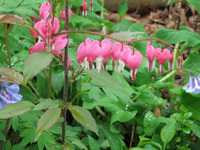Herbs , annual or perennial, scapose or caulescent, from taproots, bulblets, tubers, or rhizomes. Stems when present erect, simple or branching, hollow at maturity. Leaves basal or cauline, compound; blade with 2-4 orders of leaflets and lobes, margins entire, crenate, or serrate; surfaces glabrous, sometimes glaucous. Inflorescences axillary, extra-axillary, leaf-opposed, or terminal, unifloral or else multifloral and thyrsoid, paniculate, racemose, or corymbose. Flowers bilaterally symmetric about each of 2 perpendicular planes; sepals caducous; corolla cordate to oblong in outline; petals coherent or connate only basally, not spongy; outer petals both swollen or spurred basally, usually keeled apically; inner petals with blade fiddle-, spoon-, or arrowhead-shaped, claw linear-oblong to oblanceolate; stamens with nectariferous tissue borne on median filament in each bundle and sometimes forming spur or loop that projects into swollen base of adjacent outer petal; ovary broadly ovoid or obovoid to narrowly cylindric; stigma persistent, with 2 lobes or apical horns, sometimes also with 2 lateral papillae. Capsules indehiscent or dehiscent and 2-valved. Seeds few-many, elaiosome usually present. x = 8.
About 35 isoquinoline alkaloids have been isolated from Fumariaceae, and such compounds are present in the tissues of all species. Some of these alkaloids have been used medicinally, mostly in the past. The drug complex corydalis, which contains several alkaloids extracted from the bulblets of Dicentra canadensis and D . cucullaria , has been used as a healing agent in chronic skin diseases, as a tonic and diuretic, and in the treatment of syphilis. The alkaloid bulbocapnine, obtained from all parts of D . canadensis , has been used in the treatment of Ménière's disease and muscular tremors, and as a pre-anaesthetic. Cattle find D . cucullaria and D . canadensis distasteful and usually do not ingest the plants unless suitable forage is unavailable; when they do, however, the toxic alkaloid cucullarine brings about local anaesthesia, narcosis, convulsions, and death. A decoction from the rhizome of D . formosa has been used in the Pacific Northwest to expel intestinal worms (D. E. Moerman 1986).
Dicentra spectabilis (Linnaeus) Lemaire is cultivated through much of the flora area. It was introduced in Europe only in the middle of the 19th century, but it has been cultivated for centuries in temperate China and Japan, where it is now so widespread that the limits of its natural distribution are obscure. It does not appear to be truly naturalized in North America, but it may be encountered as a transitory garden relict or escape. It differs from D . ochroleuca and D . chrysantha in having rose-purple to pink or sometimes white outer petals, pendent flowers, and reticulate seeds with elaiosomes.
Sep minute; cor ovate or cordate, bilaterally symmetrical; pet weakly united, the outer 2 large, saccate or spurred at base, spreading or ascending at the summit, the inner much narrower, connate toward the dilated and ornamented apex, the claws separate; ovary slender, tapering to the long style; stigma with 2 crests or horns; fr generally capsular, with a persistent replum; handsome perennials with showy fls mostly in racemes or mixed panicles; in subg. Dicentra (including all our spp.) the lvs are all basal and the infl terminates a scape. (Bicuculla) 15-20, N. Amer. and e. Asia.
Gleason, Henry A. & Cronquist, Arthur J. 1991. Manual of vascular plants of northeastern United States and adjacent Canada. lxxv + 910 pp.
©The New York Botanical Garden. All rights reserved. Used by permission.








